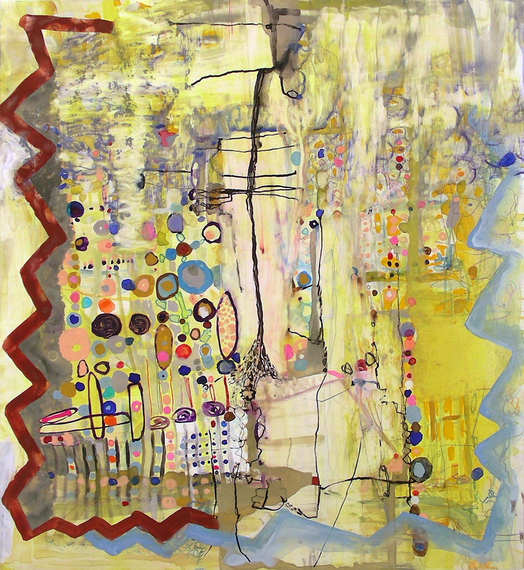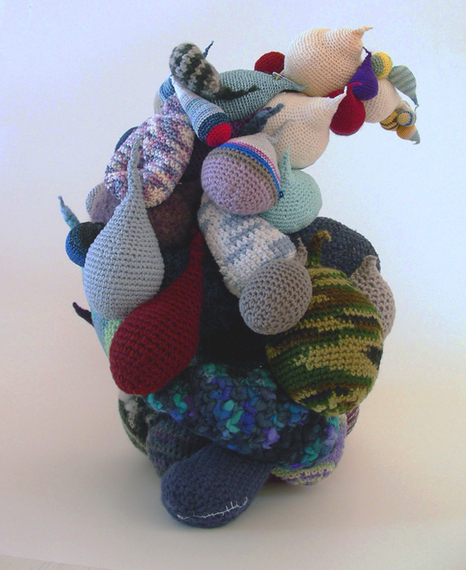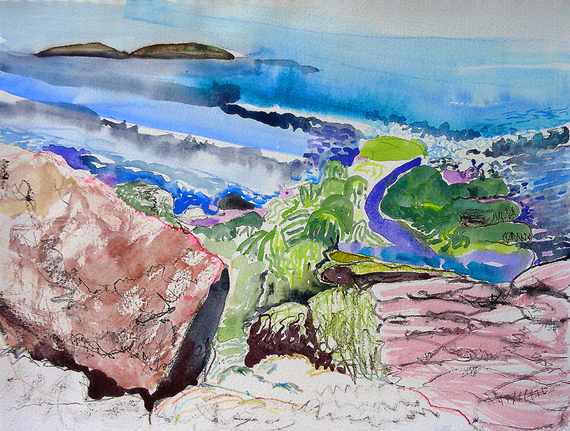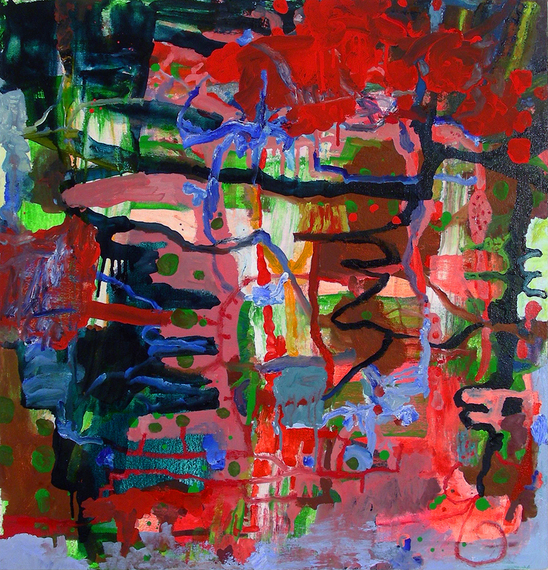A sculptor, painter and installation artist, Jeanne Tremel reveals that elusive space between visual perception and what the mind and body feels and experiences both consciously and unconsciously. It is hard to put ones finger on it, but there is this non-linear chasm an artist's imagination can fall into and instead of grabbing onto something concrete or previously believed to be the way things "should" be one allows uninhibited reactive expressions in various forms to emerge and flow. Acceptance of this process or thinking, or not thinking for that matter, is the best way to approach the multi-disciplinary art of Tremel.
Recently, I've included two of Jeanne Tremel's most curious sculptural works in a group exhibition that is opening November 12th at Galerie Protégé in New York City. The exhibition, which is titled reVision, specifically looks at the fundamentally distinctive and uniquely visceral narratives of five local artists: Paul Gagner, Stacy Greene, Eric Ramos Guerrero, Bill Gusky and Tremel.
To help clarify Tremel's work for the viewer, I took this opportunity to ask her a few questions about her multidisciplinary approach to making curiously compelling art.
DDL: Let's start with your two pieces in the show at Galerie Protégé. Bygones and Shrub Contraption have a certain elusive madness to the narrative. It's very much like what I've described in the introduction to this interview - uninhibited reactive expressions seem to emerge and flow. I wonder how much you leave up to chance in your process and how much is pre-planned in your sculptures and installations, as there is always the element of gravity one has to contend with within these fields of art.
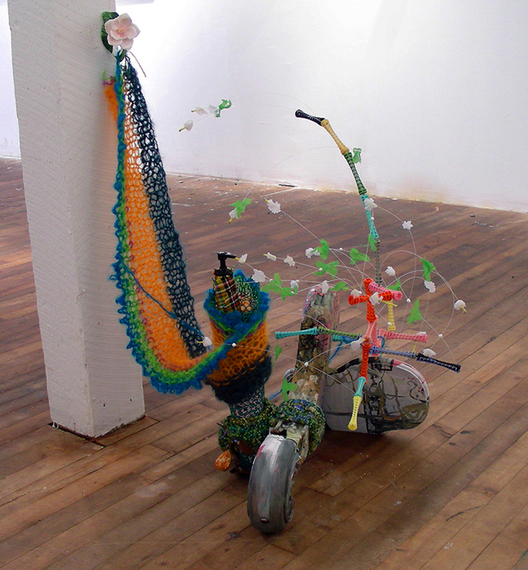
Jeanne Tremel, Shrub Contraption, wood, yarn, oil paint, ceramic piece, plastic, metal, fabric, 30" x 30" x 24", 2013
JT: Starting with Shrub Contraption. I get a thrill just remembering that freedom of following my hands, tinkering with this palette of objects I had around me, figuring and re-figuring how to attach all the various parts made of different materials - yes, the gravity part - and letting it grow. I remember feeling a satisfaction of this weird collection of stuff coming into it's own. I only coax it, really. The objects have been in my possession for a period of time - so they are already making their associations somewhere in my being. A certain broken ceramic piece reminding me of my mother, an unfinished ugly yarn project I started and gave up on, with yarn given to me by a friend, a fabric scrap from another friend that happened to match, awesomely colored plastic perm rods from a yard sale... I've come to trust that these seemingly disparate objects I've chosen to hang onto can coalesce - simply because I've chosen them.
As for Bygones -- I crocheted many tear-dropped shaped components for a year. All of them are in cool shades, but in different yarn and thread materials. I had no idea what, if anything, I'd do with them, but it felt good to do something straightforward with my hands in my grief. I was responding to the death of my father. I attached them all together with safety pins. It came out rather sad and comical looking to me and that felt right for some reason. I suppose it was forgiveness. It reminded me of a stuffed animal my dad had given me. Now that the piece has grown floppy and saggy, it seems appropriate. Time passes and feelings deflate and settle.
To your question -- Yes, I set up some process or moves to make, a pattern -- maybe that is a 'plan' and then there's always some accident or quirk that is more interesting than I could ever plan and I play with that. I work the materials into a piece and allow room for surprises that may trigger a memory or association that helps me to complete it in a satisfying way. It's really not so clear-cut though -- that a conscious verbal reckoning finishes the piece. It's more contemplative and more open-ended. Actually open-on-all-sides. That non-linear chasm you mentioned. It's the 'allowing room' part that turns an equation into something with more movement, like an expanding search that doesn't really need an end, an answer or a title.
DDL: I like the fact that your sculptural work has an autobiographical component, which relates to your very profound personal experiences while at the same time being very abstract, even somewhat removed for lack of a better word. I can also get a good sense for how you work out your ideas and experiences with color, gesture and line in your abstract paintings. Then there are the plein-air watercolors you did of the rough and rocky coastline of Maine. I can see that same energy and open-ended-ness that is obvious in your sculptures and abstract works in these more representational seascapes. Can you tell me about the genesis of these very restless, more recognizable works?
JT: I appreciate your asking about the Maine seascapes. I came to doing those about five years ago, and was able to paint on maybe three trips there. I'm particularly drawn to the water's edge and the transition between the two worlds of land and water. I look at the tree roots and rocks holding the land back and the waves and tides wearing it away. I like the details, ocean treasures, creatures and plants revealed and then hidden again by water. The on-going motion is very captivating to me -- the ocean as compared to the calm lake I grew up near in Minnesota. I have a real feeling for being around water, in observation and in imagining what's beneath the surface. I find the ocean to be fantastic and frightening.
Painting outdoors here is a real immersive conversation with the changing elements of climate and light, and especially the tide. I prefer to look down on the tableau rather than the horizon. I feel a sense of urgency to capture that energy and visual detail -- the little things I notice and want to remember -- in a relatively small window of time. Three hours can go by pretty fast and it's a treat to look at the painting and not really remember making all the marks. The spontaneity and improvisation of plein-air and making sculpture is similar as I access and bring forward my mid-life psyche and gut to the activity. Now that I think of it, when I'm making my sculpture, I'm looking down at the floor, preferably ankle deep in objects I've collected, and stirring it all up.
DDL: You mentioned Leonora Carrington in one of our recent conversations as being an artist whose work you are revisiting. What has drawn you back to her paintings and who are some of your other influences?
JT: I have an active dream life. That is, I can remember them in vivid detail and they're usually pretty dark and anxious. When I look at a lot of surrealist work, it hits me deep in that place where you say to yourself -- "Oh, it's really right there, isn't it, " and you exhale. It's very similar to an uncomfortable dream. You pause in that place, the unconscious becoming conscious, but if it's too disturbing, or truthful you can opt to avoid or forget it.
Carrington's painting's hit that spot in a way that haunts, but is also calm and accepting. As a person who experiences a lot of nightmares, these rich and complex paintings of transformation are comforting in their ambiguity. Often her imagery includes animals, or half-animal creatures that seem like gentle guardians. It's the overall mood of solitude and grace that attracts and holds me. Her depictions of her character's relationships are not only peculiar and uniquely her very own, but familiar, hinting at universal symbols and archetypes.
As far as other influences, my early arts and crafts experiences are important to me as I appreciated the quilting and needlework of my ancestors. Then as I got out into the world - I felt a real connection, when I was about 20, to Grace Hartigan's painting, Billboard, in the collection of the Minneapolis Institute of Art. I knew then that I wanted to express myself through paint and through abstraction. I had all the usual suspect Abstract Expressionists in mind and still do.
Fortunately, I had a very dedicated teacher, mentor and now friend, Anita Mills, who introduced me to the great variety of artwork by women artists in art history and in contemporary art. In the late 70's, this curriculum wasn't mainstream. There were a couple periodicals and a few books, but there were no websites about Womanhouse or tweets about Judy Chicago or other feminist artists. (Were there even computers then?) We took a class trip to the city of Chicago to see her piece, The Dinner Party - I think in 1981, which was pretty exciting on many levels. Later, I found the sculpture, installation and drawings of Louise Bourgeois to be a revelation.
Skipping back in art history again, I have to mention James Ensor, who seems to me like a crazy uncle, as I've been interested in his painting for so long. I love his macabre humor, the masks, skulls, junk store items and fleshy sea creature imagery, as well as his painting style. I also look at art by visionary artists, self-taught artists, people with mental disabilities, art of non-Western cultures. I admire and could list a whole host of contemporary artists, of course, and I feel as if I occupy a small part in a small corner of an artist community.
DDL: And finally, if I may ask about your creative connection to your artist/husband Eliot Markell - I can think of many life partnerships or lovers where a pair of creative minds have thrived, albethey embattled at times, with artist duos such as Krasner and Pollock, Sage and Tanguy, Kahlo and Rivera and Johns and Rauschenberg and I am wondering, looking at Markell's works that there might be some synergy there.
JT: Our art making is a lifestyle. All we really want to do each day is get up and paint and make things, as much as time, space and money can allow - and it's tight. The strength of our relationship is certainly something to draw upon and fuel us as individual artists. We appreciate each others support to continue being as creative as possible for as long as we can. As we've been together 10 years now, its evident there has been some crossover between our sculpture and painting processes.
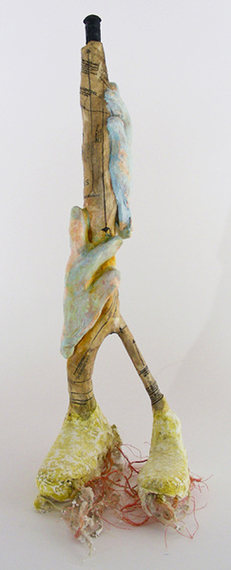
Eliot Markell, Pompeii On Parade #2, salvaged beach rope, tissue paper, rusted iron bolt, and pigment, on plaster, and driftwood, 28" x 11" x 16", 2015
Since we've been sharing a studio, Eliot has inspired me to go larger and back to oil paint. And he's been inspired to use found objects in his sculptures, including beach detritus like rope and wood. There are levels of absorption and transference of each others creative ideas that are not conscious, most likely, living with each other and our works. And then there are all the conversations on top of that. Thankfully, we work well together even though we have opposing views and different personalities. So yes, we have some synergy.

